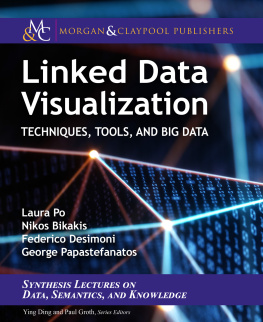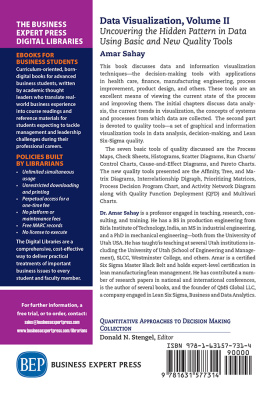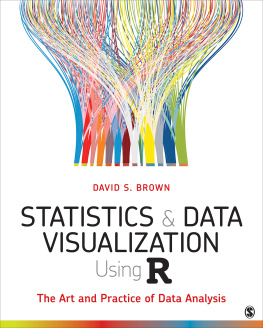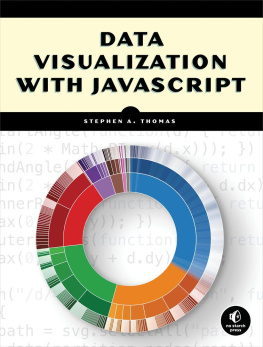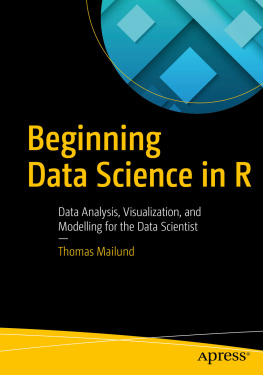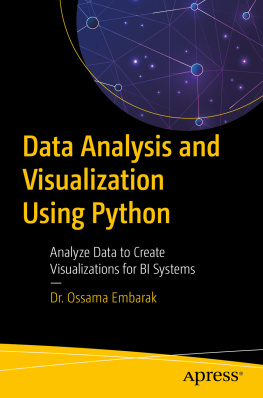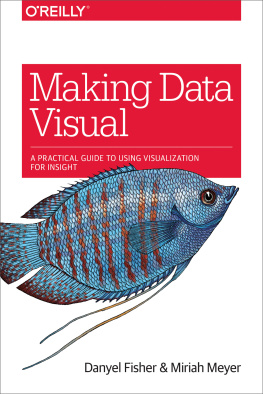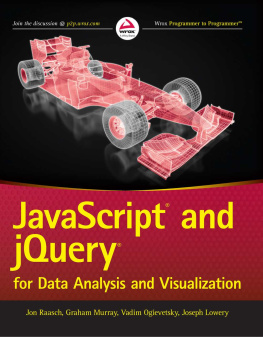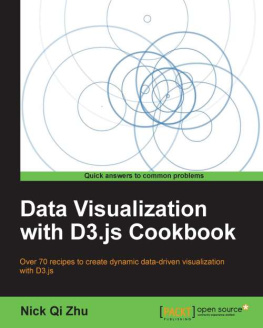
Linked Data Visualization
Techniques, Tools, and Big Data
Synthesis Lectures on Data, Semantics, and Knowledge
Editors
Ying Ding, University of Texas at Austin
Paul Groth, University of Amsterdam
Founding Editor Emeritus
James Hendler, Rensselaer Polytechnic Institute
Synthesis Lectures on Data, Semantics, and Knowledge is edited by Ying Ding of the University of Texas at Austin and Paul Groth of the University of Amsterdam. The series focuses on the pivotal role that data on the web and the emergent technologies that surround it play both in the evolution of the World Wide Web as well as applications in domains requiring data integration and semantic analysis. The large-scale availability of both structured and unstructured data on the Web has enabled radically new technologies to develop. It has impacted developments in a variety of areas including machine learning, deep learning, semantic search, and natural language processing. Knowledge and semantics are a critical foundation for the sharing, utilization, and organization of this data. The series aims both to provide pathways into the field of research and an understanding of the principles underlying these technologies for an audience of scientists, engineers, and practitioners.
Topics to be included:
Knowledge graphs, both public and private
Linked Data
Knowledge graph and automated knowledge base construction
Knowledge engineering for large-scale data
Machine reading
Uses of Semantic Web technologies
Information and knowledge integration, data fusion
Various forms of semantics on the web (e.g., ontologies, language models, and distributional semantics)
Terminology, Thesaurus, & Ontology Management
Query languages
Linked Data Visualization: Techniques, Tools, and Big Data
Laura Po, Nikos Bikakis, Federico Desimoni, and George Papastefanatos
2019
Ontology Engineering
Elisa F. Kendall and Deborah L. McGuinness
2019
Demistifying OWL for the Enterprise
Michael Uschold
2018
Validating RDF Data
Jose Emilio Labra Gayo, Eric Prudhommeaux, Iovka Boneva, and Dimitris Kontokostas
2017
Natural Language Processing for the Semantic Web
Diana Maynard, Kalina Bontcheva, and Isabelle Augenstein
2016
The Epistemology of Intelligent Semantic Web Systems
Mathieu dAquin and Enrico Motta
2016
Entity Resolution in the Web of Data
Vassilis Christophides, Vasilis Efthymiou, and Kostas Stefanidis
2015
Library Linked Data in the Cloud: OCLCs Experiments with New Models of Resource Description
Carol Jean Godby, Shenghui Wang, and Jeffrey K. Mixter
2015
Semantic Mining of Social Networks
Jie Tang and Juanzi Li
2015
Social Semantic Web Mining
Tope Omitola, Sebastin A. Ros, and John G. Breslin
2015
Semantic Breakthrough in Drug Discovery
Bin Chen, Huijun Wang, Ying Ding, and David Wild
2014
Semantics in Mobile Sensing
Zhixian Yan and Dipanjan Chakraborty
2014
Provenance: An Introduction to PROV
Luc Moreau and Paul Groth
2013
Resource-Oriented Architecture Patterns for Webs of Data
Brian Sletten
2013
Aaron Swartzs A Programmable Web: An Unfinished Work
Aaron Swartz
2013
Incentive-Centric Semantic Web Application Engineering
Elena Simperl, Roberta Cuel, and Martin Stein
2013
Publishing and Using Cultural Heritage Linked Data on the Semantic Web
Eero Hyvnen
2012
VIVO: A Semantic Approach to Scholarly Networking and Discovery
Katy Brner, Michael Conlon, Jon Corson-Rikert, and Ying Ding
2012
Linked Data: Evolving the Web into a Global Data Space
Tom Heath and Christian Bizer
2011
Copyright 2020 by Morgan & Claypool
All rights reserved. No part of this publication may be reproduced, stored in a retrieval system, or transmitted in any form or by any meanselectronic, mechanical, photocopy, recording, or any other except for brief quotations in printed reviews, without the prior permission of the publisher.
Linked Data Visualization: Techniques, Tools, and Big Data
Laura Po, Nikos Bikakis, Federico Desimoni, and George Papastefanatos
www.morganclaypool.com
ISBN: 9781681737256paperback
ISBN: 9781681737263ebook
ISBN: 9781681738345epub
ISBN: 9781681737270hardcover
DOI 10.2200/S00967ED1V01Y201911WBE019
A Publication in the Morgan & Claypool Publishers series
SYNTHESIS LECTURES ON DATA, SEMANTICS, AND KNOWLEDGE
Lecture #19
Series Editors: Ying Ding, University of Texas at Austin
Paul Groth, University of Amsterdam
Founding Editor Emeritus: James Hendler, Rensselaer Polytechnic Institute
Series ISSN
Print 2160-4711Electronic 2160-472X
Linked Data Visualization
Techniques, Tools, and Big Data
Laura Po
University of Modena and Reggio Emilia, Italy
Nikos Bikakis
University of Ioannina, Greece
Federico Desimoni
University of Modena and Reggio Emilia, Italy
George Papastefanatos
ATHENA Research Center, Greece
SYNTHESIS LECTURES ON DATA, SEMANTICS, AND KNOWLEDGE #19

ABSTRACT
Linked Data (LD) is a well-established standard for publishing and managing structured information on the Web, gathering and bridging together knowledge from different scientific and commercial domains. The development of Linked Data Visualization techniques and tools has been adopted as the established practice for the analysis of this vast amount of information by data scientists, domain experts, business users, and citizens.
This book covers a wide spectrum of visualization topics, providing an overview of the recent advances in this area, focusing on techniques, tools, and use cases of visualization and visual analysis of LD. It presents core concepts related to data visualization and LD technologies, techniques employed for data visualization based on the characteristics of data, techniques for Big Data visualization, tools and use cases in the LD context, and, finally, a thorough assessment of the usability of these tools under different scenarios.
The purpose of this book is to offer a complete guide to the evolution of LD visualization for interested readers from any background and to empower them to get started with the visual analysis of such data. This book can serve as a course textbook or as a primer for all those interested in LD and data visualization.
KEYWORDS
linked data, data visualization, visual analytics, big data, visualization tools, web of data, semantic web, data exploration, information visualization, usability evaluation, human-computer interaction
Contents
Preface
The Linked Data Principles defined by Tim Berners-Lee promise that a large portion of Web Data will be usable as one big interlinked RDF database. Today, we are assisting the staggering growth in both the production and consumption of Linked Data (LD) coming from diverse domains such as health and biology, humanities and social sciences, or open government. In the early phases of LD adoption, most efforts focused on the representation and publication of large volumes of privately held data in the form of Linked Open Data (LOD), contributing to the generation of the Linked Open Data Cloud.
Next page
